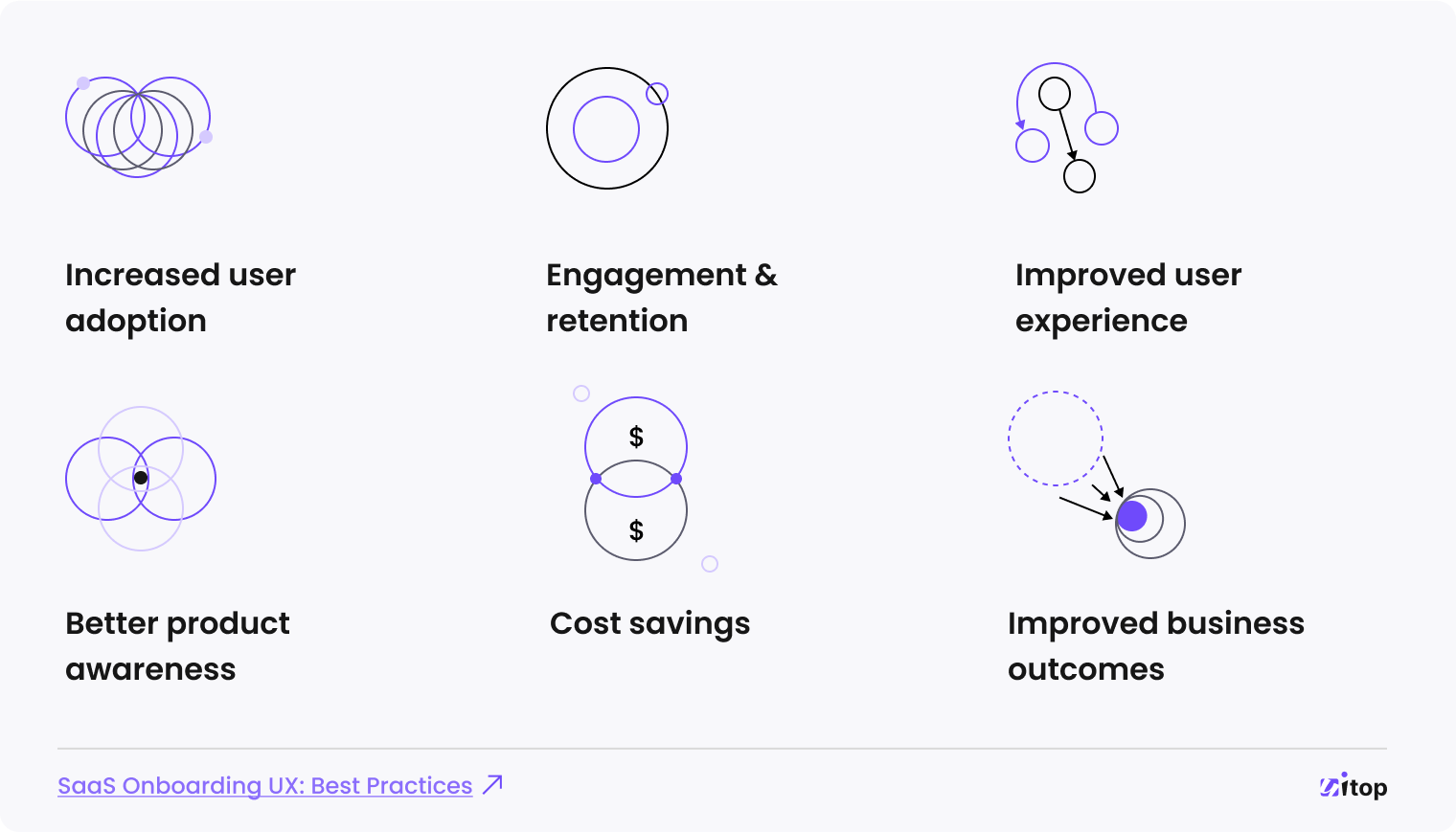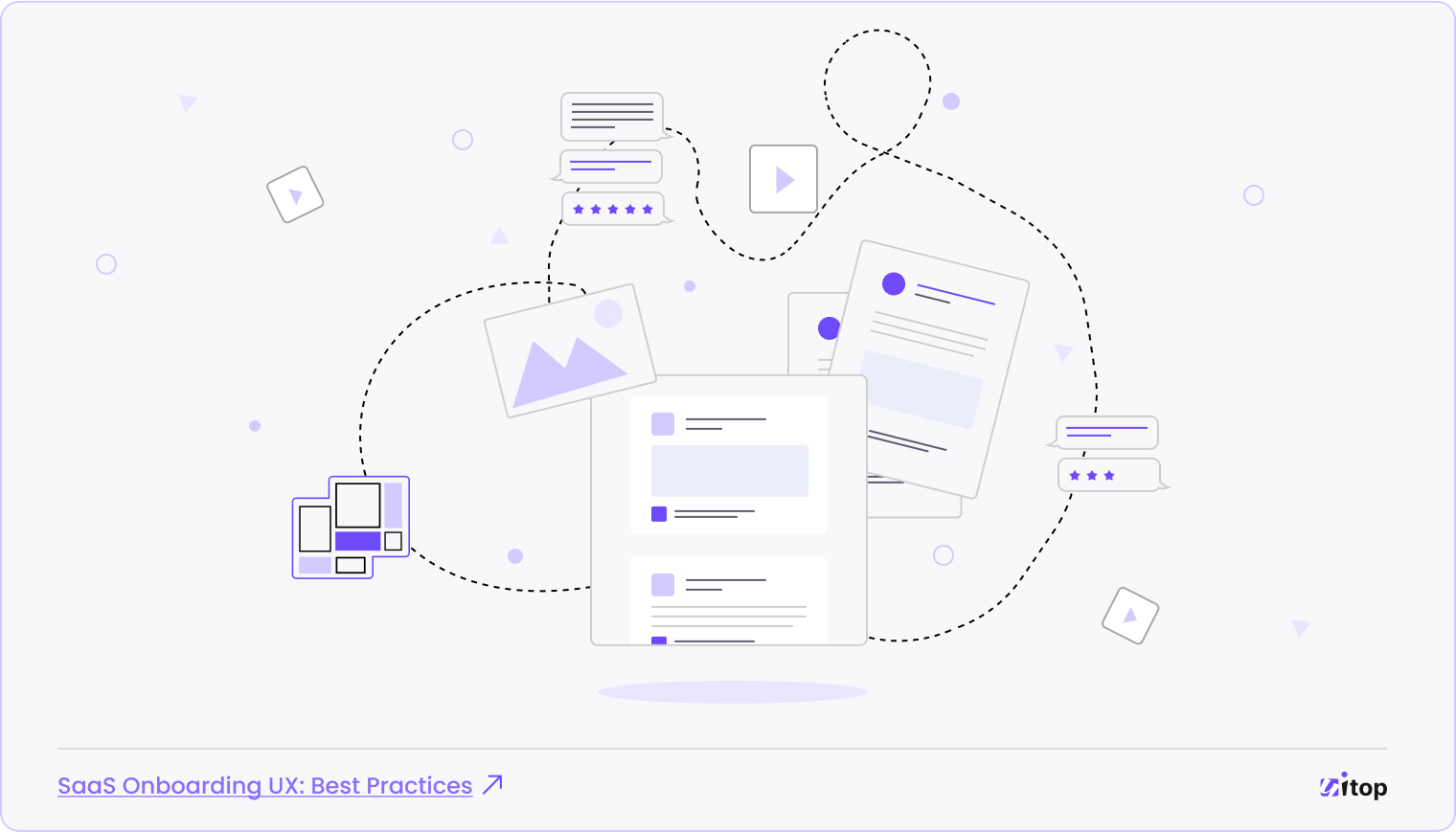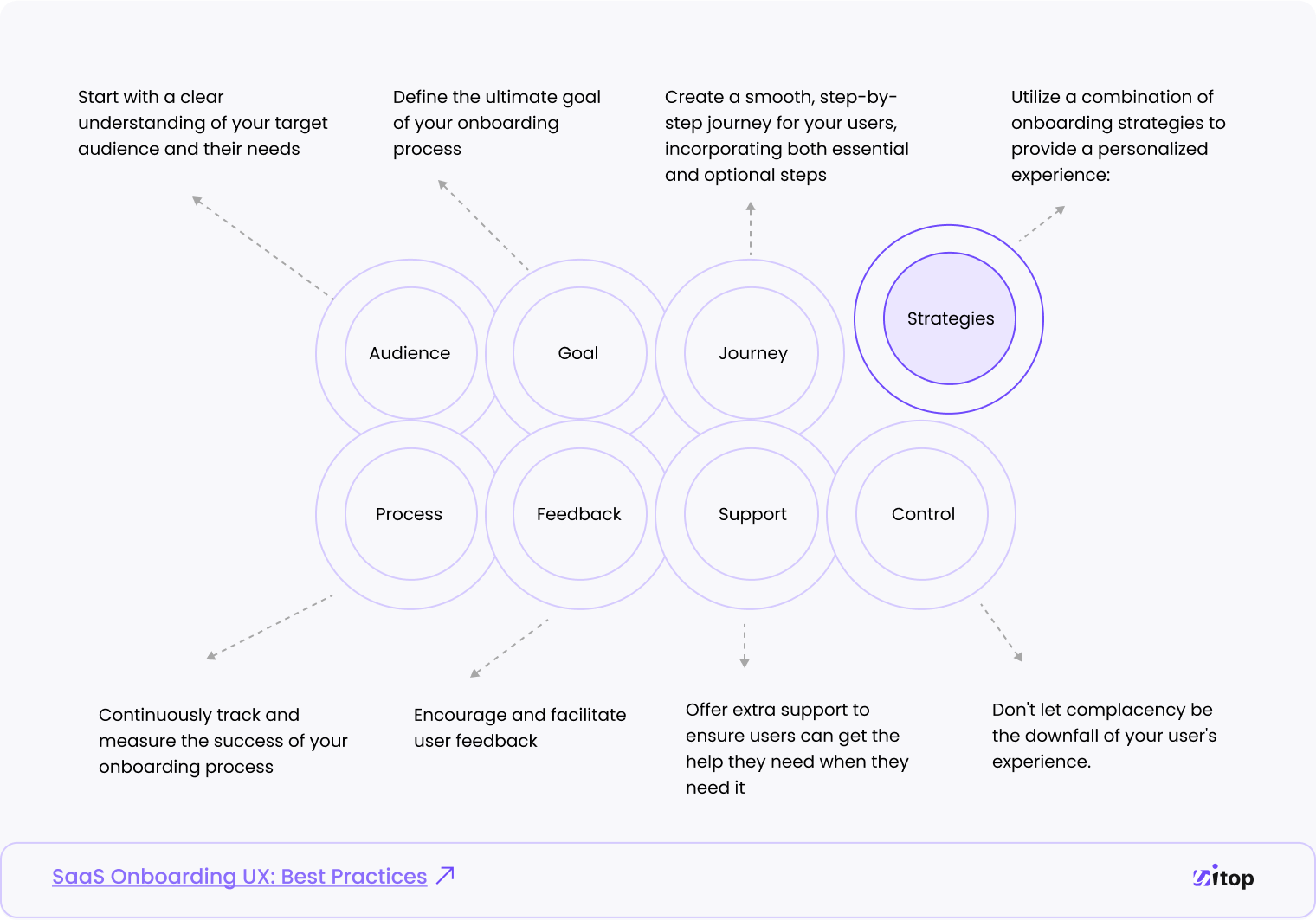What is SaaS?
If you're just beginning to research the idea of SaaS, this is the place to understand what SaaS can accomplish for you, how it works and differs, what are the main examples and what the future holds for SaaS development.
In today’s rapidly advancing SaaS industry, UX/UI design has become an indispensable aspect of a product’s success. User onboarding stands at the forefront of UX, serving as a user’s first contact with a product and laying the groundwork for their experience.
In this thought-provoking article, we explore the importance of SaaS onboarding and its impact on SaaS companies. We also present the best UX onboarding strategies. Are you ready to take your SaaS product to the next level? Let’s harness the power of first impressions together!
SaaS customer onboarding is the art and science of introducing new users to a SaaS product, helping them become familiar with the user interface and features and getting them to use it to its full potential. In essence, this is the critical first step in building a lasting relationship between the user and the SaaS product.
The exact design and structure of a SaaS onboarding process will vary depending on the product and the target audience.
However, a typical SaaS onboarding process usually consists of several key stages:
As part of the onboarding process, SaaS companies should also continuously test and refine it. This means incorporating user feedback and adjusting the process as necessary to ensure it continues to meet evolving user needs.
With the rise of the SaaS industry and increasing competition for user attention and engagement, a well-designed onboarding for SaaS is more important than ever. But what makes an onboarding process so important?
Nowadays, users expect seamless and intuitive digital experiences that enable them to adopt new software solutions quickly and easily. A good onboarding process is key to providing this type of experience and driving long-term user adoption, engagement, and business growth.

With the right onboarding process, you can achieve the following goals.
Have you ever thought about why some SaaS products succeed in attracting and retaining users while others struggle to gain a foothold? An onboarding process may be the reason. An effective onboarding process helps users quickly understand the product’s features and capabilities so they can use it more quickly and effectively. This, in turn, drives user adoption.
An effective onboarding process can increase user engagement, resulting in improved customer retention. For example, a SaaS company offering a fitness app could use onboarding to guide users through setting goals, creating a personalized workout plan, and tracking their progress. This helps users stick with the product for the long term.
The onboarding process can affect the user experience greatly. The more you show users how to use the product’s interface and features, the more likely they are to have a positive experience and keep using it.
The right onboarding process can increase awareness of the product and its features so that users can see the full value and continue to use it.
If the user onboarding process for SaaS software is too complex or takes too much time, users may become discouraged and opt for a competitor’s product. Similarly, if the onboarding for SaaS doesn’t effectively communicate the product’s key features and benefits, users may not see the value of the product. In both cases, the result is lower product awareness.
As customers are able to quickly and easily understand a product’s features and capabilities on their own, a great onboarding process can reduce the costs associated with customer support and training.
At the end of the day, the goal of any SaaS product is to drive business outcomes and growth. Through an effective onboarding process, you can enhance user adoption, engagement, and retention, resulting in a better business outcome and more opportunity for growth and scalability.
Whether you’re launching new SaaS software or adding value to an existing one, investing in a well-designed onboarding process is critical. But where should you start? First, take a look at the key strategies for designing a comprehensive onboarding process.
There are several approaches to UX onboarding in SaaS applications, each with its own strengths and best practices. Here are some examples of onboarding strategies commonly used in the SaaS industry.

This approach uses a series of screens with interactive elements, such as buttons or swipe gestures, to guide users through the app and its features. Interactive walkthroughs can be an effective way to introduce users to a new app and help them become familiar with its interface and functionality.
A walkthrough helps first-time users understand the basics of Slack, a popular team communication platform. It covers topics such as creating and joining channels and sending messages.
In this approach, users gradually learn about various features as they use the app. Progressive onboarding can ensure users feel less overwhelmed and have more control over the app, which can increase their engagement and satisfaction.
Salesforce, a customer relationship management platform, uses this onboarding strategy. Their onboarding process starts with a simple setup, followed by a series of tutorials and training to guide users through more advanced features and functionality.
The contextual onboarding process begins with a tour of the platform that provides an overview of key features and functions. Based on the context of use, users receive contextual tips and guidance.
Trello, a popular project management tool, presents information and guidance at the right time and place as users complete tasks within the app. For instance, it prompts users with a pop-up upon creating their first board to explain how to use its features.
This approach uses short, bite-sized video tutorials to introduce users to the app and its features. Onboarding videos can be engaging and entertaining, allowing users to retain information and become more interested in the app.
Dropbox, a file hosting platform, begins its user onboarding with a short video that provides an overview of the key features and functionality of the platform. The video also explains how to use the platform and provides tips for getting the most out of it.
Product demos are live, interactive demonstrations that allow users to see the product in action and try it out for themselves.
Salesforce uses demos to show users how to navigate the platform. Its demo tour provides a hands-on introduction to the platform, allowing B2B users to see how Salesforce manages and organizes customer interactions and data. The tour covers the core features of Salesforce, such as contact and lead management, opportunity management, and reporting capabilities.
Each of these onboarding strategies can be effective, depending on the app and its target audience. Now it’s time to roll up your sleeves, get creative, and develop your own onboarding design that will delight your users and set you apart from the competition.
Looking forward to launching your first SaaS project, but unsure how to effectively onboard new users? A smooth and engaging onboarding process can make the difference between a successful launch and a flop.
Or maybe you’re having a hard time retaining new users with your existing SaaS product. Let’s guess: you feel like your onboarding process falls short and leaves potential customers behind. But fear not! Read on to learn how to develop a targeted and user-centric onboarding process that will make your SaaS project a success.

Understanding your audience and their needs are the key to any successful SaaS onboarding strategy. Your onboarding UX must begin with getting to know your users — their motivations, their challenges, and their goals.
Think of your audience as the compass you use to guide every decision you make about your onboarding process. What are their problems? What do they hope to achieve with your product? How can you make their lives easier and more productive? By answering these questions and more, you can create an onboarding experience that truly engages your users.
Conduct user research, survey your current users, and get feedback from your customer support team. Use this valuable information to consider all aspects of your onboarding strategy, from how you approach them to what features you highlight.
In the world of SaaS, there is no one size fits all when it comes to onboarding. What works for one company may not work for another. That’s why it’s important to be clear about what you want to achieve with your onboarding process. Is your goal to get users up and running as quickly as possible? Or are you aiming for higher engagement and deeper retention? Whatever your goals, defining them is the first step to developing a successful onboarding strategy.
Remember, you can’t hit a target you can’t see. Setting clear onboarding goals gives you a roadmap to success and a way to measure your progress. So don’t be afraid to dream big and set lofty goals.
The key to a successful onboarding process is to create a seamless, step-by-step journey for users. Start by identifying the key phases of your onboarding process and the steps required for each phase. Also, make sure each step is clearly defined and easy to understand, with clear instructions and visual aids where needed. And, of course, ensure the steps are logically ordered so you can seamlessly guide your users from one stage to the next.
In addition, your onboarding process should include both essential and optional steps, each carefully designed to meet the needs of your target audience and achieve your goal.
Essential steps are those that must be completed in order for the client to fully understand and use your SaaS product. These include setting up an account, configuring basic settings, and walking through a tutorial.
Optional steps, on the other hand, are those that aren’t strictly necessary but can enhance the user’s overall experience. Examples of optional steps include linking social media accounts, setting up notifications, or exploring additional features.
It’s important to carefully balance the essential and optional steps when creating an onboarding journey for SaaS products.
To truly engage and retain your users, it’s critical to use a dynamic combination of interactive walkthroughs, progressive onboarding, and contextual tips. Such a multi-layered approach will allow you to personalize the onboarding process for each individual user and give them the right information at the right time. Here are some examples of how you can mix these strategies:
These are just a few examples of how you can combine different onboarding techniques to create a personalized and engaging experience for your users.
As a SaaS software creator, you’ve got the keys to the kingdom: a powerful onboarding process that sets the tone for your users’ experience. But how do you know if it’s working? The answer is simple: measure, track, and analyze. By continually monitoring metrics like churn rate and time to value, you can unlock the power of data to refine and improve your onboarding strategy, leading to long-term success.
Whether it’s identifying friction points in the user experience or uncovering opportunities for more personalized support, continuous measurement and analytics are key to designing an onboarding process that sets you apart from the competition.
So put the power of data to work for you. The results will speak for themselves!
A seamless and effective onboarding process can make all the difference to the success of your SaaS product. And one of the most valuable resources for achieving this is right at your fingertips — feedback from your users.
The more open and honest feedback you encourage and facilitate, the more insight you gain into how your users engage with your product. The information you gather from your target audience can help you continuously improve your onboarding strategy.
Start by setting up a dedicated area for feedback, whether it’s through an in-app feedback form or by establishing direct email or mobile phone contact with your support team. Don’t be afraid to accept both positive and negative feedback from your users.
Offering extra support, such as live chat or email assistance, is crucial in ensuring users have a smooth and successful experience with your SaaS product. A responsive and helpful support team can help users overcome any challenges they may encounter during their onboarding journey, ensuring they stay on track.
With a clear and accessible channel for support, users are more likely to feel confident and empowered, reducing the risk of churn and increasing their chances of becoming loyal customers. You can demonstrate your commitment to your users’ success by offering top-notch support, creating a more positive and memorable experience for them.
Don’t let complacency be the downfall of your user’s experience. Keep your ear to the ground and your eyes on the prize. Refine and optimize your onboarding approach over time, always seeking ways to enhance the user journey and drive success for your SaaS solution. The journey to greatness never ends, but the destination is well worth the effort!
The key to a successful SaaS product lies in its onboarding process. By understanding your target audience, defining clear goals, creating a personalized journey, and continuously refining your strategy, you can ensure that new users are engaged, empowered, and ultimately, converted into loyal customers.
So, don’t settle for a mediocre onboarding experience — take the time to craft the best onboarding design that sets your SaaS software apart and drives long-term success.

The purpose of a SaaS onboarding process is to help new users understand how to use the product effectively, so they can start realizing value from it as soon as possible. A good onboarding process can also increase user engagement and reduce churn.
Some common onboarding techniques for SaaS products include interactive walkthroughs, progressive onboarding, contextual tips, video onboarding, and demo onboarding. The best approach will depend on the specific needs of your target audience and the goals of your onboarding process.
To track the success of your SaaS onboarding process, you should use metrics such as churn rate, time to value, and user engagement. You should also encourage user feedback and continually seek ways to refine and optimize your onboarding strategy over time.
To ensure that your SaaS onboarding process provides a personalized experience for each user, you should utilize a combination of onboarding techniques, such as interactive walkthroughs, progressive onboarding, and contextual tips. You should also consider offering extra support, such as live chat or email assistance, to ensure users can get the help they need when they need it.
You may also be interested
What is SaaS?
If you're just beginning to research the idea of SaaS, this is the place to understand what SaaS can accomplish for you, how it works and differs, what are the main examples and what the future holds for SaaS development.
What is the difference between a Product Design and a UX Design?
The contrast between product design and UX design is widely debated given the wide variety of design positions that are presently available. One might think that these two terms are similar or even the same, however, each is unique and has a specific role and focus area during the product development process. Keep reading to […]
Business SaaS Software Categories
The advent of software-as-a-service (SaaS) solutions has ushered in a new era in technology and business. Gone are the days of complicated installations, high licensing fees, and all the headaches that come with them. SaaS represents a paradigm shift away from traditional, time-consuming, and costly methods of software delivery to a more flexible, cost-effective, and […]
Let’s discuss your product needs
“They took extra time to ensure that our frontend developer could easily implement the wireframes.”


Your Project Starts Here!
Our processes with your needs in mind drives any SaaS product growth. Let’s see how our approach aligns with your vision.
Let’s discuss your design challenges
Please leave your email so we can contact you

Tell us a little more about your product so we can estimate it
We'll help you make the right choice!
Leave your email to receive regular updates to your inbox